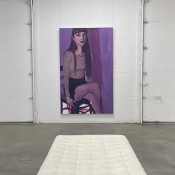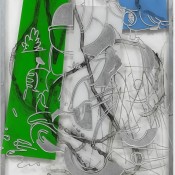15-12
SHELLEY ADLER AND JOE FLEMING | HERRINGER KISS
Herringer Kiss Gallery
101, 1615 - 10 Avenue S.W.
Calgary, T3C 0J7, Canada
tel: 403.228.4889
email: deborah@herringerkissgallery.com
posted by herringer kiss gallery
event website
October 15, 2022 - November 12, 2022
Reception:
October 15, 2:00pm - 5:00pm
The juxtaposition of work by Adler and Fleming is not an obvious choice. Adler’s canvases are luscious figurative paintings of women, whereas Fleming sprays, stencils and incises panels of acrylic to create abstract compositions. Yet for both, drawing is key. Adler and Fleming are both masters of what art history tells us was called cartoon in the Middle Ages. At that time, the term cartoon connoted the line-art used to plot out murals and tapestries. It was the underpinnings of an eventual work, not finished art to be seen on its own. For Adler and Fleming though, cartoon is both the solid backbone and the elegant surface of their work, and the inspiration to show together for the first time.
Adler uses a highly contemporary form of cartoon, first popularized in the nineteen-century to satirize politicians and socialites by exaggerating their posture or features to highlight failings like fakery or weakness. In the case of Adler’s paintings though, such exaggerations serve to stylize her subjects. They are more akin to the history of fashion, where things like bustles and corsets, mini-skirts and Jackie-O glasses, have been the fashion designer’s invitation to find new ways of looking at the female form. A further similarity, is that Adler’s women are always clothed. They are studies of the self-image women choose to put out in the world, and make bold use of colour, shape, or pose, as deliberately as any Instagram post. However, Adler’s women appear to be caught in an off-moment of doubt or self-absorption, at ease in a way their social-media selves would never allow. Adler’s paintings turn the eyes that women reserve for other women on themselves. The paintings are the farthest thing from the studies of female anatomy, or the familiar pre-coitus or post-coitus sketches executed by male artists that fill museums. Who better than a woman to show us the difference?
Fleming comes to the idea of the cartoon as defined a century later, in the characters, line work, and cherubic forms epitomized by Disney. The familiar icons don’t appear in his work for laughs or storytelling though, in fact, they are not entirely there at all. Fleming only presents us with fragments, but in the best tradition of animation, they race, slide, and collide across the painting’s surface. These are disobedient cartoons, and so of course the colour resides outside the lines, stencilled or squeegeed according to their frenzied rhythm. Still, the viewer knows the familiar childlike energy of the shapes and linework so well, that recognition is immediate, and the mind accelerates eager to put it all together. But then, something different happens. What appeared at first to be a nostalgic puzzle, begins to feel more like Humpty Dumpty destined to be forever broken. The shapes feel brutally truncated and the underpainting a protest, like inner city graffiti. Fleming astutely captures our collective attachment to innocence, amid the tenuous framework of our grown-up lives
While the idea of the cartoon links Adler and Fleming’s work, the context of a two-person show also serves as opportunity for these two Canadian painters to link to place. Adler and Fleming have selected unique works specifically for the Calgary space, inspired by the lyric of the legendary Albertan artist Joni Mitchell: “On the back of a cartoon coaster.” In addition to Mitchell’s prodigious talent as a songwriter and musician, she herself is a visual artist. The song A Case of You from which the lyric is drawn, is rich with references to drawing and painting. The resulting works by Adler and Fleming come together much like the coasters of two strangers in a bar. Once a conversation between drinkers begins, the space between them closes and their coasters are stained by the abstract calligraphy of spilled spirits, or marked by doodles or diagrams made to illustrate a point. Adler and Fleming each make their marks with a similar combination of serendipity and intent. The paintings juxtapose highly personal interpretations of their shared conversation around the idea: On the back of a cartoon coaster.
Written by Jane Hope, Writer and Designer based in New York and Toronto.


